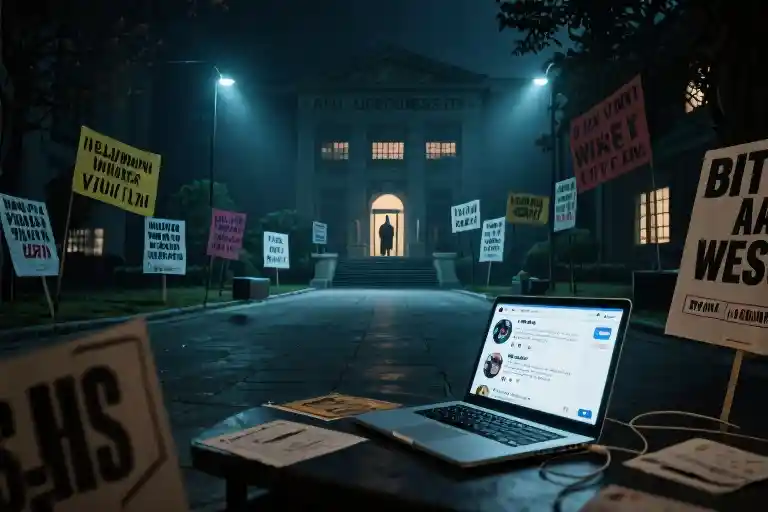The first time I heard someone call me a ‘godless degenerate,’ I was standing on the quad at my university, holding a coffee that suddenly tasted like acid. A traveling preacher named Brother Jed had set up his microphone near the library, hurling condemnations at students passing by. His wife Cindy threw an unopened box of condoms at a group of us, declaring them ‘your God.’ Later that semester, a different kind of speaker arrived—a polished man in a blazer who talked about ‘racial realism’ and ‘demographic threats.’ His words didn’t scream like Jed’s; they slithered, wrapping around vulnerable minds with academic-sounding phrases about ‘cultural preservation.’
These encounters left me with a question that still lingers: When hate comes dressed as free speech or intellectual debate, who should bear the burden of listening? The easy answer is ‘no one’—we could dismiss these voices as unworthy of attention. But the harder truth is that understanding hate speech might be necessary to dismantle it. Not everyone should have to endure that exposure, though. Those of us with privilege—white skin, citizenship, tenure, or simply the safety to walk away—must choose to engage so others don’t have to.
Universities often become battlegrounds for this tension. On one side, free speech absolutists argue that even the vilest ideas deserve a platform. On the other, marginalized students rightly ask why their education should include debates about their humanity. When Jared Taylor spoke at Colorado Mesa University about ‘White advocacy,’ or when Charlie Kirk told University of Wyoming students that diversity initiatives were ‘the enforcement arm of critical race theory,’ these weren’t abstract philosophical exchanges. For students of color, these events meant sitting in class the next day beside peers who applauded speakers questioning their right to be there.
The digital age twisted this dynamic. Hate speech no longer requires a campus invitation—it floods social media feeds, hides in meme culture, and gets amplified by algorithms designed to maximize engagement. A single white supremacist speaker might reach dozens in person but thousands online, where their ideas mutate through shares and comments. What used to be confined to a contentious afternoon on the quad now lingers indefinitely in search results and recommendation feeds.
This isn’t just about hurt feelings. Words shape reality. When politicians echo ‘great replacement’ conspiracy theories or influencers dismiss racism as ‘reverse discrimination,’ they’re not just expressing opinions—they’re building permission structures for violence. The 2017 Charlottesville marchers chanting ‘Jews will not replace us’ didn’t emerge from nowhere; they were steeped in rhetoric that had been normalized through campus speeches, YouTube channels, and think tank reports dressed up as scholarship.
Yet banning hate speech often backfires. It drives extremists underground, where their ideas fester without scrutiny. It also misses the point: the problem isn’t just individual speakers but the systems that elevate them. Why do universities fund ‘controversial’ speakers through student activity fees? Why do social media algorithms prioritize outrage? Why do some professors remain silent when colleagues platform racist pseudoscience?
There’s an uncomfortable lesson here: we can’t combat hate without understanding it. But that understanding shouldn’t fall to those already targeted by it. White students, tenured faculty, and tech executives have a responsibility to analyze and counter these ideas precisely because they’re less likely to face retaliation for doing so. This work is grueling—it means dissecting racist logic, monitoring extremist forums, and having painful conversations with relatives who’ve fallen down ideological rabbit holes. But it’s work that can’t be outsourced to the vulnerable.
What I didn’t realize back on that quad, coffee going cold in my hand, was that the real test wasn’t whether we allowed hate speech on campus. It was whether those of us with safety nets would step forward to catch its weight.
The Dual Battlefield of Hate Speech: From Campus to Digital Spaces
During my undergraduate years, I remember walking past a crowd gathered around an open-air preacher who called us ‘godless degenerates.’ That same semester, a white nationalist group tabled on the quad with pamphlets claiming Blackness was ‘a disease.’ These weren’t isolated incidents – they were part of a calculated strategy to normalize extremist ideologies in academic spaces. What’s changed in recent years isn’t the existence of hate speech, but its propagation channels. Where once these ideas required physical campus invitations, they now flow unchecked through digital pipelines directly into students’ pockets.
The case of Jared Taylor’s 2023 appearance at Colorado Mesa University illustrates this shift. When the self-described ‘white advocate’ spoke about racial separatism, the event itself lasted ninety minutes. But the digital aftermath persisted for months – clips shared on extremist forums, algorithmic amplification on social media, and pseudo-intellectual commentary dressed as campus debate. Students who’d never set foot in the lecture hall encountered Taylor’s ideas through recommended videos and targeted ads. This is the new reality: hate speech no longer stays contained within the bounds of scheduled campus events.
Three distinct but interconnected spaces now form hate speech’s ecosystem:
- Physical Campus Events: Carefully orchestrated appearances by figures like Taylor or Charlie Kirk that lend legitimacy to extremist views while testing institutional tolerance. These function as content farms for digital redistribution.
- Social Media Platforms: Where algorithms identify and target potentially receptive students. A single interaction with controversial campus content trains recommendation systems to serve increasingly extreme material.
- Gaming/Alternative Platforms: Spaces like Discord or in-game chats where racist ideologies spread through memes and ‘ironic’ humor, often reaching students who’d never attend a far-right speaker event.
The Southern Poverty Law Center’s research shows how white nationalist groups deliberately exploit this ecosystem. Their 2022 report documented how organizations like Taylor’s American Renaissance create ‘campus controversy’ content designed to:
- Provoke emotional reactions that drive social media engagement
- Generate debate footage that can be decontextualized into viral clips
- Identify and recruit students who engage with the material
What makes this particularly insidious is the way digital platforms erase the line between voluntary exposure and involuntary encounter. Where students once chose to attend (or avoid) physical events, recommendation systems now force-feed hateful content under guises like ‘campus free speech debates’ or ‘controversial opinions.’ A Black student researching for class might find white nationalist literature suggested as ‘related reading’ by academic databases. An international student checking campus news could have anti-immigrant propaganda appear alongside event announcements.
This digital permeation creates a psychological toll distinct from isolated campus incidents. When hate speech enters through devices students rely on for coursework, socialization, and basic campus navigation, there’s no clean separation between academic life and ideological assault. The classroom lecture ends at the bell; the algorithmic recommendations keep coming.
University administrators wrestling with free speech questions often overlook this critical dimension. Policies designed for a pre-digital era – debating whether to allow controversial speakers – fail to address how those speeches live on digitally long after the microphone gets turned off. Meanwhile, the very platforms amplifying this content face no parallel scrutiny to campus speech committees.
We’re left with a disturbing asymmetry: hate speech enjoys both the legitimacy of physical campus platforms and the unrestrained reach of digital networks, while counter-speech struggles to gain equal footing in either space. Until we recognize this dual battlefield, our defenses will remain hopelessly outmatched.
The Paradox of Free Speech and the Double-Edged Sword of Empathy
The First Amendment stands as a bedrock principle in American democracy, protecting even the most vile expressions under its expansive shield. This legal reality creates an uncomfortable tension on university campuses, where the ideals of open inquiry collide with the lived experiences of marginalized students. When the Supreme Court ruled in Snyder v. Phelps that Westboro Baptist Church’s hateful protests at military funerals constituted protected speech, it reinforced a difficult truth: the law often values the right to speak over the right to be free from harm.
This legal framework shapes campus environments in profound ways. White nationalist speakers like Jared Taylor can invoke constitutional protections while arguing for racial separation, leaving students of color to grapple with the cognitive dissonance of being told they belong in classrooms where their humanity becomes debate fodder. The psychological toll compounds when administrators cite free speech principles while declining to intervene, as happened at Colorado Mesa University when faculty advised objecting students to simply “let it go.”
When Empathy Becomes Weaponized
Empathy operates as a curious paradox in these conflicts. Black musician Daryl Davis demonstrated its transformative power by befriending and convincing hundreds of KKK members to abandon white supremacy through patient dialogue. His approach worked precisely because he extended understanding to people espousing hateful ideologies – a strategy that required emotional labor few could sustain.
Yet this same empathetic impulse can be twisted to serve harmful ends. When audiences applaud Charlie Kirk’s dehumanizing rhetoric about undocumented immigrants or nod along to Jared Taylor’s pseudoscientific racial theories, they’re often exercising a warped form of empathy – identifying with the speaker’s perceived grievances while ignoring the consequences for targeted communities. This selective compassion creates what scholar Sara Ahmed calls “affective economies,” where emotional responses circulate to reinforce existing power structures rather than challenge them.
The Listening Conundrum
Janice Radway’s observation that “listening is not eating” offers crucial guidance here. We can choose how to process what we hear, but this agency isn’t equally distributed. For privileged listeners, engaging with hate speech might represent an intellectual exercise. For marginalized students, it often feels like swallowing poison – each racist trope or xenophobic argument eroding their sense of safety in educational spaces.
The critical distinction lies in who bears the burden of this listening. When universities invite controversial speakers under the banner of free speech, they’re frequently asking vulnerable populations to pay the emotional price for others’ education. This dynamic flips the purpose of higher education on its head, prioritizing the enlightenment of some over the wellbeing of others.
Beyond Binary Thinking
Moving past this impasse requires rejecting false dichotomies. The choice isn’t between censorship and laissez-faire tolerance, but about creating structures that:
- Distinguish between mere offense and genuine harm
- Allocate the work of confronting hate according to privilege rather than vulnerability
- Provide tangible support systems for those most affected
This approach acknowledges that while suppressing speech often backfires, unchecked amplification of harmful rhetoric through campus platforms and social media algorithms causes measurable damage. The path forward lies in cultivating what Danielle Allen calls “participatory readiness” – the collective capacity to engage across differences without demanding the most vulnerable do the heaviest lifting.
As universities grapple with these challenges, they might consider models like the University of Chicago’s Center for Effective Government, which trains students in “listening across differences” while maintaining clear boundaries against dehumanizing speech. Such initiatives recognize that free speech protections represent the floor, not the ceiling, of ethical educational practice – and that true intellectual community requires more than legal minimalism.
The Privileged Burden: Who Should Bear the Cost of Listening?
The first time I saw a White student walk out during Jared Taylor’s campus speech, I felt a pang of recognition. Not sympathy—recognition. Their leather jacket and half-empty coffee cup suggested a morning lecture interrupted by curiosity rather than trauma. Meanwhile, my Black classmates sat rigid in their seats, jaws clenched like they were weathering a hailstorm. This is the unspoken hierarchy of hate speech exposure: some attend as spectators, others as targets.
Defining the Privilege to Look Away
Privilege in this context isn’t about wealth or education—it’s the biological lightness in your chest when hate speech targets someone else’s identity. It’s the ability to debate “free speech principles” over dinner because no one questioned your right to sit at the table. Three markers reveal who holds this privilege:
- Racial immunity: When White nationalists speak of “racial separatism,” your body isn’t the one being discussed for removal
- Citizenship certainty: No one waves your parents’ immigration papers as evidence of national decay
- Identity elasticity: You can disengage from the conversation without it feeling like self-betrayal
A psychology professor once told me privilege is best measured by what you don’t remember. The students who forget Taylor’s speech by weekend aren’t irresponsible—they’re experiencing the normal function of unburdened cognition.
The Threefold Task
For those with privilege, engaging with hate speech isn’t about martyrdom—it’s about redistributing cognitive labor. Here’s how that translates to campus life:
1. Strategic Listening (The Notetaker Role)
- Document rhetorical patterns: Are they using “genetic IQ studies” as racial proxies? Framing deportation as “population control”?
- Track audience reactions: Which lines get applause? Nervous laughter? This reveals community fault lines
- Example: At University of Michigan, a sociology TA created a hate speech “rhetorical playbook” later used to train debate teams
2. Compassionate Disruption (The Interpreter Role)
- In classroom discussions: “When Taylor said ‘peaceful ethnic cleansing,’ how might international students hear that phrase differently?”
- On social media: “This meme about ‘Black crime rates’ actually cites a discredited 1970s study—here’s the retraction notice”
- Crucial distinction: Correct ideas, not people. The goal is dismantling arguments, not humiliating peers
3. Structural Shielding (The Buffer Role)
- Physical: Sitting between marginalized students and known harassers at events
- Digital: Reporting algorithmically amplified hate content (with screenshots for evidence)
- Emotional: “I’ll attend the Q&A so you can skip it”—actual text from a White ally to a Latina student prepping for finals
The Accountability Paradox
Here’s what this work isn’t: absolution. A philosophy major once confessed he attended hate speeches “to feel less guilty about being White.” That’s privilege laundering—using anti-racism as emotional tax evasion. Real responsibility means:
- Accepting that your presence may unintentionally legitimize speakers (Why do colleges advertise “controversial events draw diverse crowds!” as if that’s progress?)
- Recognizing when to step back (A Muslim student doesn’t need your “help” explaining Islamophobia to the Islamophobe)
- Measuring impact by reduction in harm, not accumulation of woke credentials
When Institutions Fail
After the Western Culture Club incident, Colorado Mesa’s administration argued they were “protecting all viewpoints.” But neutrality always favors the aggressor. Privileged allies must sometimes become institutional sandpaper:
- File Title VI complaints for racially hostile environments (Yes, even for “academic” hate speech)
- Demand faculty advisors receive trauma-informed training
- Withhold alumni donations until protection policies change
A tenured professor once told me, “Our job isn’t to keep students comfortable.” True. But it’s not to make them endangered either. The classroom windows at my old university still have bulletproof film from a 2016 neo-Nazi shooting threat. Some costs are too high to outsource.
The Digital Sharecropping Problem
Online, privileged users often “share hate speech to condemn it,” accidentally boosting its reach. Before reposting that vile tweet:
- Does your critique add new analysis? Or just perform outrage?
- Could a screenshot (without tags/links) achieve the same goal?
- Have you DM’d support to those targeted instead of giving the harasser more attention?
Data shows White users discussing racism get more algorithmic reward than Black users experiencing it. Reset the scales.
The Privilege Checklist
Before attending any hate speech event, ask:
☐ Am I emotionally prepared to dissect this later for vulnerable peers?
☐ Do I have exit strategies if overwhelmed? (Privilege includes leaving when you choose)
☐ What’s my post-event commitment? (e.g., “I’ll write the op-ed so survivors don’t have to”)
At its core, this isn’t about guilt—it’s about capacity. The same way we don’t expect wheelchair users to “just climb stairs,” we shouldn’t demand the most targeted among us bear the brunt of dismantling hate. There’s courage in stepping forward. There’s justice in stepping up.
Digital Strategies Against Hate: Navigating Algorithmic Extremism
The shift from physical campuses to digital spaces hasn’t diminished hate speech—it’s simply changed the battlefield. Where once white supremacists needed university invitations to spread their ideology, today’s algorithms provide automated amplification, pushing extremist content into unsuspecting students’ feeds with terrifying efficiency. This new landscape demands equally sophisticated counterstrategies.
How Recommendation Systems Radicalize
Social media platforms operate on engagement-driven models where controversy fuels clicks. When a student lingers on a politically charged post—even to disagree—machine learning interprets that hesitation as interest. The system responds by serving increasingly extreme content, creating what researchers call the ‘rabbit hole effect.’ A 2022 study by the Tech Transparency Project found YouTube recommending white nationalist videos after users watched mainstream conservative content within just five clicks.
These algorithms don’t distinguish between academic debate and hate speech. Jared Taylor’s American Renaissance website, labeled a hate group by the SPLC, gets boosted alongside legitimate sociology papers because both discuss ‘racial differences.’ The sanitized language of ‘racial realism’ or ‘demographic concerns’ slips through content filters while carrying the same poisonous ideology as overt slurs.
Educational Firewalls: Teaching Digital Discernment
Universities can’t block every harmful site, but they can immunize students through media literacy programs that:
- Decode Linguistic Camouflage – Show how phrases like ‘European heritage preservation’ map to segregationist ideologies through historical examples
- Trace Funding Networks – Reveal how pseudo-academic organizations like the Charles Darwin Research Institute funnel white nationalist money
- Simulate Algorithm Manipulation – Let students experience how innocuous searches get steered toward extremism in controlled environments
The University of Michigan’s Digital Rhetoric Collaborative offers workshops where students reverse-engineer radicalization pathways. One exercise has them track how a search for ‘immigration statistics’ might lead to white nationalist blogs through intermediate recommendations.
Technological Countermeasures
While education builds critical thinking, technical solutions can disrupt hate’s spread:
- Browser Extensions like HateBlock (a conceptual tool) could flag known hate speech patterns in comment sections and suggest counter-narratives
- Alternative Recommendation Algorithms being developed at Stanford’s Human-Centered AI lab prioritize ‘bridge content’ that connects differing viewpoints rather than pushing users to extremes
- Crowdsourced Warning Systems allow students to report disguised hate speech with tags like ‘#AcademicHate’ for community moderation
The Privilege of Logging Off
Here’s the uncomfortable truth: marginalized students don’t have the luxury of avoiding these spaces. When racist content floods campus forums, Black and brown students must choose between enduring harm or abandoning crucial academic discussions. Privileged allies can help by:
- Monitoring Toxic Spaces – White students volunteering to track extremist channels and summarize relevant discussions without exposing vulnerable peers
- Disrupting Amplification – Intentionally engaging with counter-content to ‘hack’ recommendation algorithms toward inclusive material
- Providing Exit Ramps – Creating alternative discussion platforms with explicit content moderation policies
As Gloria Ladson-Billings reminds us, racism operates through systems, not just slurs. Fighting digital hate requires equally systemic solutions—where educators, technologists, and privileged students build firewalls not of censorship, but of critical awareness and ethical design.
Rebuilding Belonging: Mending the Cracks Hate Leaves Behind
The posters advertising Jared Taylor’s talk still clung to campus bulletin boards when Jamal stopped attending his morning sociology seminar. By week’s end, three more students of color had quietly withdrawn from class discussions. What happens after the auditorium empties and the news crews leave matters more than the spectacle itself – the real damage festers in library carrels where students question whether they truly belong, in dining halls where lunch tables become racialized territories, in the exhausted silence of marginalized faculty members expected to endlessly educate their colleagues.
When the Ground Feels Unsteady
Universities often treat hate speech incidents as contained events rather than symptoms of systemic fractures. A Black student at Colorado Mesa described walking past Taylor’s event flyers as “like seeing your humanity debated as a theoretical exercise – except your dorm key still has to work the next morning.” This psychological toll demands more than reactive counseling services; it requires rebuilding what sociologists call “institutional courage” – the collective willingness to name harm, redistribute power, and redesign systems.
Effective responses share three traits:
- Visibility: After white supremacist flyers appeared at University of Vermont, faculty wore “Hate Has No Home Here” buttons for months, creating visual solidarity.
- Infrastructure: UCLA’s Office of Equity Initiatives trains student “belonging ambassadors” to facilitate post-incident dialogues.
- Accountability: When conservative students at Smith College invited a speaker denying systemic racism, the administration paired the event with mandatory workshops on racial microaggressions.
The Privilege of Public Commitment
White student alliances at over 60 campuses now issue counter-statements when extremist speakers visit, modeled after Oberlin College’s “We Dissent” initiative. These groups:
- Crowdsource funds to cover security costs for marginalized student protests
- Maintain public logs of faculty/staff who decline to sign solidarity statements
- Organize “listening sessions” where affected students dictate terms of engagement
“It’s not about comfort,” explains Dartmouth senior Priya Chatterjee. “When white students handle the logistics of resistance, it lets us preserve energy for healing.”
Algorithms Won’t Hug You Back
Digital hate’s omnipresence necessitates offline sanctuaries. The most effective spaces:
- Curate sensory relief: Howard University’s “Black Joy” room features tactile art projects and curated playlists overriding traumatic content
- Center bodily autonomy: Portland State’s healing circles begin with participants mapping where they physically carry stress
- Leverage institutional memory: Oral history projects like UC Berkeley’s “Resistance Archives” connect current students with alumni who survived prior hate waves
A queer student at University of Kentucky described their campus’s “Rebuilding Nights” simply: “For three hours weekly, the internet doesn’t exist, and neither does the weight in my chest.”
The Metrics That Matter
Traditional diversity metrics – headcounts, retention rates – fail to capture belonging’s nuances. Forward-thinking institutions now track:
- Spatial comfort: Heat maps showing where marginalized students cluster vs. avoid
- Narrative ownership: Percentage of crisis response statements drafted by affected communities
- Repair attempts: Documented instances of privileged groups intervening in microaggressions
As Stanford’s Vice Provost for Equity recently noted: “We can’t audit our way into belonging. The work lives in a thousand daily choices to remake our shared spaces.”
This isn’t about returning to “normal” – normal bred the fractures. It’s about co-creating campuses where safety isn’t a privilege negotiated at the margins, but a foundation sturdy enough to hold difficult conversations without crumbling.
The Weight We Carry Together
The work of confronting hate speech is never done by individuals alone. It’s a collective burden that must be distributed according to privilege and vulnerability. What becomes clear after examining campus controversies and digital amplification is that we’re all implicated in this ecosystem – some as targets, some as perpetrators, and far too many as silent bystanders.
Systemic change requires acknowledging how deeply these patterns are woven into our institutions. When university administrations prioritize abstract free speech principles over the safety of marginalized students, they’re making a choice about whose comfort matters more. When social media platforms optimize for engagement at all costs, they’re deciding that racial trauma is an acceptable byproduct of their business model. These aren’t neutral positions; they’re active reinforcements of the status quo.
Yet within this bleak landscape, there are glimmers of how we might redistribute this weight more justly. The student organizers who create alternative safe spaces when their institutions fail them. The professors who redesign curricula to include critical media literacy against extremist rhetoric. The technologists building tools to disrupt algorithmic radicalization. These efforts matter precisely because they reject the false dichotomy between free expression and safety – proving we can have rigorous debate without sacrificing human dignity.
Where Do We Go From Here?
Action begins with recognizing your position in this ecosystem. For privileged readers, that might mean:
- Committing to monitor extremist content in your professional field or campus organizations
- Intervening when colleagues share dehumanizing rhetoric disguised as intellectual debate
- Creating structured opportunities for marginalized voices to lead these conversations
For those directly targeted by hate speech, the priority must be self-preservation. No one should feel obligated to engage with content that threatens their fundamental worth. Your wellbeing isn’t negotiable currency for someone else’s education.
The Tools We Need
Several resources already exist for those ready to act:
- The Southern Poverty Law Center’s Hatewatch monitors extremist movements
- Media literacy programs like News Literacy Project teach source evaluation skills
- Algorithmic accountability tools such as Blacklight reveal tracking practices
These are starting points, not solutions. The deeper work happens in departmental meetings where faculty debate speaker invitations, in tech company boardrooms where engineers push back on engagement metrics, in family gatherings where someone finally challenges racist remarks instead of letting them pass.
An Uncomfortable Question
As you finish reading, consider this: In your community, who’s currently bearing the emotional labor of confronting hate? Is it always the same faces at every protest, the usual names signing every open letter? What would it look like for others to step forward?
There are no perfect answers here, only the daily choice between complicity and resistance. What matters isn’t having a grand theory of change, but doing the imperfect work right in front of you – then showing up again tomorrow.





